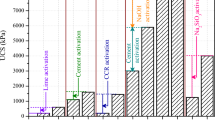Abstract
Coastal cities are in desperate need of suitable land to meet the ever-increasing demand for urban infrastructure to support commercial, residential, tourism, and off-shore activities. Countries with a lengthy coastal line, such as India, possess significant areas of widespread highly saline soils subjected to periodic seawater intrusion. One such soil stratum was encountered in the Gulf of Cambay, Bhavnagar district, Gujarat, India. Due to the high volume of river runoff, the Gulf has a positive water balance. The relative humidity ranges from 65 to 86%, making the climate semi-arid to sub-humid. The high salinity, mineral content, basaltic origin, and deeper water table offered the impetus to investigate the applicability of various soil treatment options for such saline soils. Admixture stabilization techniques have been shown to help with problematic soil features. The Current study aims to determine the effectiveness of the addition of locally available lignite fly ash (10–30% by weight) and cement (6–9% by weight) to Bhavnagar saline soil in respect of strength, electrical conductivity, and CBR. In this assessment, a comparison of stabilized and unstabilized saline soil mixtures is expected to highlight the need of understanding the influence of treatment on the instinctive performance of stabilized saline soils, as well as assist practitioners in efficacious treatment of extreme saline soils for diverse geotechnical and construction applications.
Access this chapter
Tax calculation will be finalised at checkout
Purchases are for personal use only
Similar content being viewed by others
References
Akpokodje EG (1985) The stabilization of some arid zone soils with cement and lime. Q J Eng GeolHydrogeol 18(2):173–180
Cockrell CF, Leonard JW (1970) Characterization and utilization studies on limestone modified flyash, vol 60. Coal Research Bureau, West Virginia University
Cokca E (2001) Use of class c fly ashes for the stabilization of an expansive soil. J Geotech Geoenviron Eng 127(7):568–573
Congress IR (2018) Guidelines for the design of flexible pavements. Indian code of practice, IRC, 37
Congress IR (2015) Guidelines for the design of Flexible Pavements for Low volume rural roads. Indian code of practice, IRC, SP 72
He B, Cai YL, Ran WR et al (2014) Spatial and seasonal variations of soil salinity following vegetation restoration in coastal saline land in eastern China. CATENA 118:147–153
IS 14767 (2000) Methods of test for soils-determination of the specific electrical conductivity of soils. Bureau of Indian Standards, New Delhi
IS 2720 part 16 (1987). Methods of test for soils: Part 16 Laboratory determination of CBR. Bureau of Indian Standards, New Delhi
IS 2720-Part 10 (1991) Methods of test for soils-Determination of unconfined compressive strength. Bureau of Indian Standards, New Delhi
IS 2720-Part 4 (1985) Methods of test for soils: Part 4 Grain size analysis. Bureau of Indian Standards, New Delhi
IS 2720-Part 5 (1985) Methods of test for soils: Part 5: Determination of liquid and plastic limit. Bureau of Indian Standards, New Delhi
Jakhrani AQ, Samo SR, Sobuz HR, Uddin MA, Ahsan MJ, Hasan NMS (2012) Assessment of dissolved salts concentration of seawater in the vicinity of Karachi. Int J Struct Civ Eng 1(2):61–69
Kaniraj SR, Havanagi VG (1999) Compressive strength of cement stabilized fly ash-soil mixtures. Cem Concr Res 29(5):673–677
Ma W, Brown PW (1997) Hydrothermal reactions of fly ash with Ca(OH)2 and CaSO4 2H2O. Cem Concr Res 27(8):1237–1248
Mehta B, Sachan A (2017) Effect of mineralogical properties of expansive soil on its mechanical behavior. Geotech Geol Eng 35(6):2923–2934
Messad A, Moussai B (2016) Effect of water salinity on Atterberg limits of El-Hodna sabkha soil. Bull Eng Geol Environ 75(1):301–309
Moncmanová A (2007) Environmental factors that influence the deterioration of materials. Environ Deterior Mater 21:1
Murmu AL, Dhole N, Patel A (2020) Stabilisation of black cotton soil for subgrade application using fly ash geopolymer. Road Mater Pavement Des 21(3):867–885
Naveena S, Reddy GS (2015) Strength characteristics of expansive soils using eco-friendly Xanthan Gum. Int J Sci Res 6(6):2439–2442
Notman CF (2011) Durability testing of fine grained stabilised soils. Doctoral dissertation, University of Nottingham
Onyejekwe S, Ghataora GS (2015) Soil stabilization using proprietary liquid chemical stabilizers: sulphonated oil and a polymer. Bull Eng Geol Environ 74(2):651–665
Pandian NS, Krishna KC, Leelavathamma B (2002) Effect of fly ash on the CBR behaviour of soils. In: Indian geotechnical conference, vol 1. Allahabad, pp 183–186
Rahmat MN, Kinuthia JM (2011) Compaction of fills involving stabilisation of expansive soils. Proc Inst Civ Eng-Geotech Eng 164(2):113–126
Senol A, Bin-Shafique MS, Edil TB, Benson CH (2002) Use of class C fly ash for stabilization of soft subgrade. In: Fifth international congress on advances in civil engineering. Istanbul Technical University, Istanbul, Turkey, pp 25–27
Teerawattanasuk C, Voottipruex P (2019) Comparison between cement and fly ash geopolymer for stabilized marginal lateritic soil as road material. Int J Pavement Eng 20(11):1264–1274
USDA. United States Department of Agriculture (2014) https://www.nrcs.usda.gov. Accessed 20 Jan 2022
Wei L, Chai S, Guo Q, Wang P, Li F (2020) Mechanical properties and stabilizing mechanism of stabilized saline soils with four stabilizers. Bull Eng Geol Env 79(10):5341–5354
Author information
Authors and Affiliations
Corresponding author
Editor information
Editors and Affiliations
Rights and permissions
Copyright information
© 2024 Deep Foundations Institute
About this paper
Cite this paper
Parmar, J., Prasad, P.S., Pandya, S., Peddinti, P.R.T. (2024). Geotechnical Assessment of Highly Saline Soil Stabilized with Fly Ash–Cement Admixtures. In: Krishna, A.M., Banerjee, S., Pitchumani, N.K. (eds) Deep Foundations for Infrastructure Development in India. DFIIndia 2022. Lecture Notes in Civil Engineering, vol 373. Springer, Cham. https://doi.org/10.1007/978-3-031-37256-8_18
Download citation
DOI: https://doi.org/10.1007/978-3-031-37256-8_18
Published:
Publisher Name: Springer, Cham
Print ISBN: 978-3-031-37255-1
Online ISBN: 978-3-031-37256-8
eBook Packages: EngineeringEngineering (R0)




